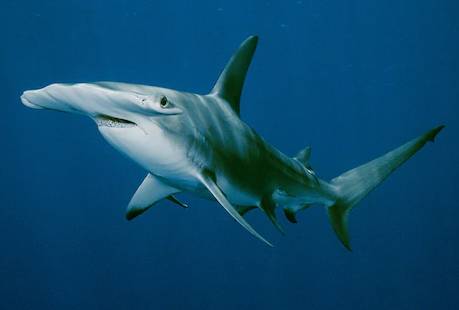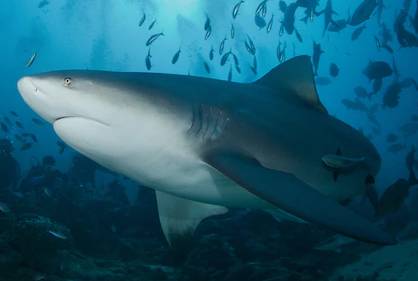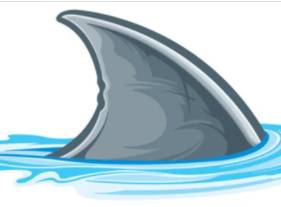Bài học cùng chủ đề
Báo cáo học liệu
Mua học liệu
Mua học liệu:
-
Số dư ví của bạn: 0 coin - 0 Xu
-
Nếu mua học liệu này bạn sẽ bị trừ: 2 coin\Xu
Để nhận Coin\Xu, bạn có thể:

Practice SVIP
Match.



Hammerhead sharks gets their unusual name from the unusual shape of its head, an amazing piece of anatomy built to help them find its favorite meal: stingrays.
A hammerhead shark uses its wide head to trap stingrays by pinning them to the seafloor. The shark's eye placement, on each end of its very wide head, allows it to scan more area more quickly than other sharks can. The hammerhead also has special sensors across its head that helps it scan for food in the ocean.
The shark hunts alone, and can find stingrays that hide under the sand on the seafloor. Hammerheads also eat bony fishes, crabs, squid, lobsters, and other sea creatures. The upper sides of these fish are grayish-brown or olive-green and they have white bellies. Hammerheads' mouths are on the underside of their heads.
Unlike many fish, hammerheads do not lay eggs. A female gives birth to live young. One litter can range from six to about 50 pups. When a hammerhead pup is born, its head is more rounded than its parents'. There have been very few recorded attacks on people by the great hammerhead.
Read the passage and choose the correct answer.
What is hammer sharks' favourite prey?
Hammerhead sharks gets their unusual name from the unusual shape of its head, an amazing piece of anatomy built to help them find its favorite meal: stingrays.
A hammerhead shark uses its wide head to trap stingrays by pinning them to the seafloor. The shark's eye placement, on each end of its very wide head, allows it to scan more area more quickly than other sharks can. The hammerhead also has special sensors across its head that helps it scan for food in the ocean.
The shark hunts alone, and can find stingrays that hide under the sand on the seafloor. Hammerheads also eat bony fishes, crabs, squid, lobsters, and other sea creatures. The upper sides of these fish are grayish-brown or olive-green and they have white bellies. Hammerheads' mouths are on the underside of their heads.
Unlike many fish, hammerheads do not lay eggs. A female gives birth to live young. One litter can range from six to about 50 pups. When a hammerhead pup is born, its head is more rounded than its parents'. There have been very few recorded attacks on people by the great hammerhead.
Read the passage and choose the correct answer.
Where are the shark's eyes?
Hammerhead sharks gets their unusual name from the unusual shape of its head, an amazing piece of anatomy built to help them find its favorite meal: stingrays.
A hammerhead shark uses its wide head to trap stingrays by pinning them to the seafloor. The shark's eye placement, on each end of its very wide head, allows it to scan more area more quickly than other sharks can. The hammerhead also has special sensors across its head that helps it scan for food in the ocean.
The shark hunts alone, and can find stingrays that hide under the sand on the seafloor. Hammerheads also eat bony fishes, crabs, squid, lobsters, and other sea creatures. The upper sides of these fish are grayish-brown or olive-green and they have white bellies. Hammerheads' mouths are on the underside of their heads.
Unlike many fish, hammerheads do not lay eggs. A female gives birth to live young. One litter can range from six to about 50 pups. When a hammerhead pup is born, its head is more rounded than its parents'. There have been very few recorded attacks on people by the great hammerhead.
Read the passage and choose the correct answer.
What colour are the the shark's bellies?
Hammerhead sharks gets their unusual name from the unusual shape of its head, an amazing piece of anatomy built to help them find its favorite meal: stingrays.
A hammerhead shark uses its wide head to trap stingrays by pinning them to the seafloor. The shark's eye placement, on each end of its very wide head, allows it to scan more area more quickly than other sharks can. The hammerhead also has special sensors across its head that helps it scan for food in the ocean.
The shark hunts alone, and can find stingrays that hide under the sand on the seafloor. Hammerheads also eat bony fishes, crabs, squid, lobsters, and other sea creatures. The upper sides of these fish are grayish-brown or olive-green and they have white bellies. Hammerheads' mouths are on the underside of their heads.
Unlike many fish, hammerheads do not lay eggs. A female gives birth to live young. One litter can range from six to about 50 pups. When a hammerhead pup is born, its head is more rounded than its parents'. There have been very few recorded attacks on people by the great hammerhead.
Read the passage and choose the correct answer.
A baby hammerhead is called _______.
Hammerhead sharks gets their unusual name from the unusual shape of its head, an amazing piece of anatomy built to help them find its favorite meal: stingrays.
A hammerhead shark uses its wide head to trap stingrays by pinning them to the seafloor. The shark's eye placement, on each end of its very wide head, allows it to scan more area more quickly than other sharks can. The hammerhead also has special sensors across its head that helps it scan for food in the ocean.
The shark hunts alone, and can find stingrays that hide under the sand on the seafloor. Hammerheads also eat bony fishes, crabs, squid, lobsters, and other sea creatures. The upper sides of these fish are grayish-brown or olive-green and they have white bellies. Hammerheads' mouths are on the underside of their heads.
Unlike many fish, hammerheads do not lay eggs. A female gives birth to live young. One litter can range from six to about 50 pups. When a hammerhead pup is born, its head is more rounded than its parents'. There have been very few recorded attacks on people by the great hammerhead.
Read the passage and choose the correct answer.
Which of the following is NOT true about hammerhead sharks?
Match.



Seahorses are tiny fishes that are named for the shape of their head, which looks like the head of a tiny horse. There are at least 25 species of seahorses. You'll find seahorses in the world's tropical and temperate coastal waters, swimming upright among seaweed and other plants. Seahorses use their dorsal fins (back fins) to propel slowly forward. To move up and down, seahorses adjust the volume of air in their swim bladders, which is an air pocket inside their bodies. Their tail can hold objects, helpful when seahorses want to anchor themselves to vegetation.
A female seahorse lays dozens, sometimes hundreds, of eggs in a pouch on the male seahorse's abdomen. Seahorse young hatch after up to 45 days in brood pouch. The baby seahorses, each about the size of a jelly bean, find other baby seahorses and float together in small groups, clinging to each other using their tails. Unlike kangaroos, baby seahorses do not return to the pouch. They must find food and hide from predators as soon as they're born.
Read the text and fill in the blank with only ONE word/number.
Seahorses get their name because their look like a horse.
Seahorses are tiny fishes that are named for the shape of their head, which looks like the head of a tiny horse. There are at least 25 species of seahorses. You'll find seahorses in the world's tropical and temperate coastal waters, swimming upright among seaweed and other plants. Seahorses use their dorsal fins (back fins) to propel slowly forward. To move up and down, seahorses adjust the volume of air in their swim bladders, which is an air pocket inside their bodies. Their tail can hold objects, helpful when seahorses want to anchor themselves to vegetation.
A female seahorse lays dozens, sometimes hundreds, of eggs in a pouch on the male seahorse's abdomen. Seahorse young hatch after up to 45 days in brood pouch. The baby seahorses, each about the size of a jelly bean, find other baby seahorses and float together in small groups, clinging to each other using their tails. Unlike kangaroos, baby seahorses do not return to the pouch. They must find food and hide from predators as soon as they're born.
Read the text and fill in the blank with only ONE word/number.
There are more than species of seahorses.
Seahorses are tiny fishes that are named for the shape of their head, which looks like the head of a tiny horse. There are at least 25 species of seahorses. You'll find seahorses in the world's tropical and temperate coastal waters, swimming upright among seaweed and other plants. Seahorses use their dorsal fins (back fins) to propel slowly forward. To move up and down, seahorses adjust the volume of air in their swim bladders, which is an air pocket inside their bodies. Their tail can hold objects, helpful when seahorses want to anchor themselves to vegetation.
A female seahorse lays dozens, sometimes hundreds, of eggs in a pouch on the male seahorse's abdomen. Seahorse young hatch after up to 45 days in brood pouch. The baby seahorses, each about the size of a jelly bean, find other baby seahorses and float together in small groups, clinging to each other using their tails. Unlike kangaroos, baby seahorses do not return to the pouch. They must find food and hide from predators as soon as they're born.
Read the text and fill in the blank with only ONE word/number.
Seahorses live in and temperate coastal waters.
Seahorses are tiny fishes that are named for the shape of their head, which looks like the head of a tiny horse. There are at least 25 species of seahorses. You'll find seahorses in the world's tropical and temperate coastal waters, swimming upright among seaweed and other plants. Seahorses use their dorsal fins (back fins) to propel slowly forward. To move up and down, seahorses adjust the volume of air in their swim bladders, which is an air pocket inside their bodies. Their tail can hold objects, helpful when seahorses want to anchor themselves to vegetation.
A female seahorse lays dozens, sometimes hundreds, of eggs in a pouch on the male seahorse's abdomen. Seahorse young hatch after up to 45 days in brood pouch. The baby seahorses, each about the size of a jelly bean, find other baby seahorses and float together in small groups, clinging to each other using their tails. Unlike kangaroos, baby seahorses do not return to the pouch. They must find food and hide from predators as soon as they're born.
Read the text and fill in the blank with only ONE word/number.
To move forward, seahorses use their fins.
Seahorses are tiny fishes that are named for the shape of their head, which looks like the head of a tiny horse. There are at least 25 species of seahorses. You'll find seahorses in the world's tropical and temperate coastal waters, swimming upright among seaweed and other plants. Seahorses use their dorsal fins (back fins) to propel slowly forward. To move up and down, seahorses adjust the volume of air in their swim bladders, which is an air pocket inside their bodies. Their tail can hold objects, helpful when seahorses want to anchor themselves to vegetation.
A female seahorse lays dozens, sometimes hundreds, of eggs in a pouch on the male seahorse's abdomen. Seahorse young hatch after up to 45 days in brood pouch. The baby seahorses, each about the size of a jelly bean, find other baby seahorses and float together in small groups, clinging to each other using their tails. Unlike kangaroos, baby seahorses do not return to the pouch. They must find food and hide from predators as soon as they're born.
Read the text and fill in the blank with only ONE word/number.
Baby seahorses float in small groups, using their to cling to each other.
Rearrange to make a meaningful sentence.
Rearrange to make a meaningful sentence.
Rearrange to make a meaningful sentence.


Bạn có thể đánh giá bài học này ở đây